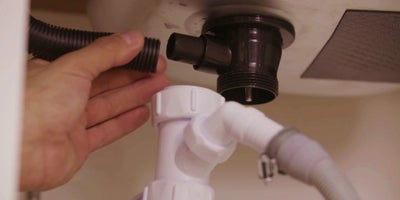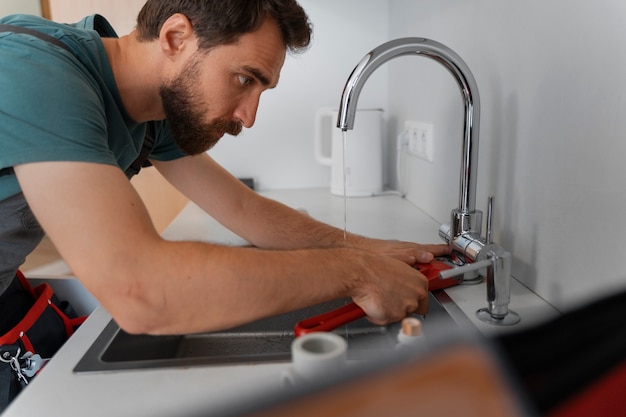Crucial Steps To Correct A Slow-Draining Sink
Crucial Steps To Correct A Slow-Draining Sink
Blog Article
Each person seems to have their own idea on the subject of Solved! How to Fix a Slow Sink Drain.

Intro
We have actually all existed: You're brushing your teeth or washing your hands, and you discover the water pooling in the sink. As opposed to swiftly swirling down the drain, it lingers, transforming your once-refreshing early morning routine right into a mini swamp scene. A slow-draining sink isn't simply irritating; it's typically a sign of larger plumbing concerns hiding beneath the surface. The bright side is that many slow-draining sinks can be taken care of with a little know-how, a couple of standard devices, and some perseverance. Ready to tackle this job head-on? Allow's roll up our sleeves and dive right in.
Comprehending the Sources Of a Slow-Draining Sink
Before you begin poking around in your pipes, it assists to know what may be causing the slowdown. Recognizing the root cause makes it easier to select the appropriate repair.
Tools and Products You'll Require
The right tools make all the difference. Fortunately, you won't require a fully stocked plumbing's van to finish the job.
Step-by-Step Guide to Fixing a Slow-Draining Sink
Currently, allow's get into the nitty-gritty. This step-by-step procedure will lead you via basic techniques to recover your sink's drainage.
Action 1: Get Rid Of and Clean the Stopper
Commonly, the stopper (that small plug you lower to block water) is the first wrongdoer. Remove it very carefully and clean off any kind of hair or gunk entraped around its base. Rinse it thoroughly prior to putting it back in position.
Step 2: Make Use Of a Plunger to Displace Debris
Got that plunger ready? Placement it over the drainpipe and give it a couple of company pumps. The idea is to develop suction that can loosen any kind of blockage. If you see littles particles drifting up, you're on the appropriate track.
Action 3: Attempt a Drain Serpent or Cable Wall Mount
If the bettor does not suffice, it's time to highlight the drain snake. Gently feed it right into the drainpipe and spin as you go. You could feel some resistance-- that's likely the clog. Maintain twisting and drawing until you get rid of the blockage. If you don't have a drainpipe snake, an aligned cord wall mount can work in a pinch.
Tip 4: Apply a Do It Yourself Drainpipe Cleanser
A natural cleaner made from baking soft drink and vinegar can break down residual crud. Pour half a mug of cooking soda into the drainpipe, complied with by half a cup of vinegar. Allow it fizz for about 15 mins, then flush with hot water. This chain reaction commonly does wonders for small clogs.
Tip 5: Rebuild and Examine the Sink
Put every little thing back together and run the faucet. Does the water currently swirl down the tubes at a commendable rate? If yes, offer on your own a pat on the back. Otherwise, don't despair-- there are still a couple of more dress up your sleeve.
Essential Tools for DIY Services
A plunger is your best starting point. A little, sink-sized plunger develops suction that can displace minor clogs. For even more consistent blockages, a drainpipe serpent (in some cases called a plumbing professional's auger) functions wonders. A pair of handwear covers, a flashlight, and possibly a set of safety goggles are also handy.
Advised Cleaning Solutions
Moderate meal soap and hot water can aid break down greasy build-up. A mix of cooking soda and vinegar is a time-tested natural remedy, and enzymatic cleaners offer a more eco-friendly technique. Keep chemical drain cleansers as a last option, as they can be rough on your pipelines.
Usual Culprits Behind Slow Water Drainage
So, what's blocking points up? Typically, it's a blend of day-to-day particles-- think hair, soap residue, tooth paste deposit, and leftover food particles. Over time, these little bits gather and hold on to the pipe wall surfaces, progressively tightening the passage and making it harder for water to pass through. In some cases, natural resource from difficult water can additionally contribute to the substance, producing the excellent tornado for persistent clogs.
When is it Time to Take Action?
If you notice the water draining slower than usual, it's an excellent concept to intervene sooner rather than later. Waiting too long could bring about complete blockages, unpleasant odors, or even pipeline damages. If the water takes more than a few secs to remove after shutting off the tap, consider it a red flag and get ready to put on your DIY hat.
Security First: Precautions and Prep work
Before you launch into unclogging mode, think of security. You're taking care of potentially dirty water and particles, so slip on a set of handwear covers. If you're making use of chemical cleaners, guarantee the room is well-ventilated and comply with the directions on the tag.
Protective Equipment and Office Arrangement
Put down some old towels or rags around the sink area to catch sprinkles. Clear away any products that might get in your way, like soap dispensers or tooth brush holders. See to it you have excellent lighting-- get a flashlight if needed.
Alternate Techniques for Stubborn Clogs
Not all obstructions are created equivalent. If your sink still refuses to cooperate, take into consideration these alternative options.
Baking Soda and Vinegar Method
We already discussed this, yet it's worth keeping in mind once more. This mild, environment-friendly technique is much safer than chemical cleansers and commonly quite reliable.
Enzymatic Drainpipe Cleaners
Enzyme-based cleansers make use of all-natural microorganisms to digest organic matter. They're an exceptional selection if you're seeking to stay clear of harsh chemicals. Just remember, they might take a bit longer to function their magic.
Chemical Drain Cleaning Company: Advantages And Disadvantages
Chemical cleaners can blow up through challenging blockages quick, yet they're not without drawbacks. They can create warmth and fumes, damage pipelines if utilized exceedingly, and posture ecological threats. Use them sparingly, and always follow the instructions very carefully.
Safety Nets to Keep Your Sink Flowing
Prevention is the very best treatment. By embracing a couple of easy habits, you can keep your sink from decreasing to begin with.
Regular Cleaning Up Routines
Clean down the sink container and fixture location frequently. Remove hair or food fragments prior to they have an opportunity to wash down the drain.
Preventing Unsafe Materials Down The Tubes
Hesitate before dumping coffee premises, oil, or fibrous vegetable scraps down the sink. These wrongdoers cling to pipe wall surfaces, developing clogs gradually.
Regular Maintenance Checks
Schedule a quick regular monthly examination. Run warm water through the sink for a few mins, paying attention to the flow. If it appears slow, act fast before it becomes a full-on clog.
When to Call an Expert Plumbing
Sometimes, regardless of just how difficult you try, that obstruct just won't move. That's when it's time to bring in the pros.
Indicators That Show a Much More Serious Issue
If your sink drains gradually despite numerous efforts, or if you notice water backing up in other fixtures (like your shower or commode), you might have a much more major plumbing issue prowling much deeper in the system.
Balancing DIY Initiatives with Professional Assistance
While do it yourself can save you money and provide a feeling of achievement, there's no shame in calling a specialist. An expert plumber can examine your whole plumbing arrangement, making sure there's no underlying damages or long-lasting trouble that can cost you much more in the future.
Comparing Expenses and Long-Term Solutions
Prior to deciding, take into consideration the big picture. An inexpensive, quick fix may address the trouble momentarily, yet purchasing a much more long-term service could save you money and tension over time.
Considering the Expenditures of DIY vs. Specialist Fixes
Do it yourself fixes often set you back bit greater than the rate of a bettor or a container of cooking soft drink. Specialist solutions, on the other hand, featured a price tag yet might prevent repeated concerns and expensive repair work later.
Buying High Quality Fixtures and Upgrades
If your sink's style contributes to frequent obstructions, it could be worth updating to higher-quality components or modifying the pipes format. Consider this a financial investment in your house's capability and comfort.
Conclusion
A slow-draining sink can feel like a minor irritation, but it's commonly an indicator that your plumbing needs a little tender loving care. By recognizing the root causes, using the right tools and techniques, and devoting to easy preventive measures, you can maintain your sink streaming freely. And when all else fails, never ever be reluctant to hire an expert-- your home's pipes is worth the financial investment in care and upkeep.
Three Common Ways to Fix a Slow Drain
Baking Soda Method
Boil a full pot of water. Measure out cup of baking soda and pour it down the drain. Then take cup of the magical cleansing substance known as white vinegar and drop that down there too. Allow the mixture to fizz in the drain for five minutes as the vinegar and baking soda combine. Now dump in that whole pot of boiling water. This combination of cleaning substances should clear out anything that is causing your sink to drain slowly. If it doesn t...
Zip-It
If the baking soda method doesn t clear out your drain, it may be because a significant amount of hair and/or other debris has collected there and you need to remove it. Purchase a Zip-It tool at any home improvement or hardware store and insert it into your drain. It will catch any collected hair or debris that s blocking the flow of water. Pull it out. If it s got a big clump of hair, etc. on the end, you ve probably got your culprit.
Drain Cleaner
If these methods don t work, there is the standard drain cleaner that you can also buy in a hardware store or even your local grocery store. It s better if you can use a household solution, but these drain cleaners often work in a pinch. They re very simple to use. You generally just dump them in your drain and wait. If even this method is not effective, it may be time to call the plumber.
https://www.mrrooter.com/oneida/about-us/blog/2017/july/three-common-ways-to-fix-a-slow-drain/

Hopefully you liked our section about Solved! How to Fix a Slow Sink Drain. Thanks so much for finding the time to read through our posting. Don't hesitate to take the opportunity to promote this blog post if you liked it. Thank-you for going through it.
Call Today Report this page